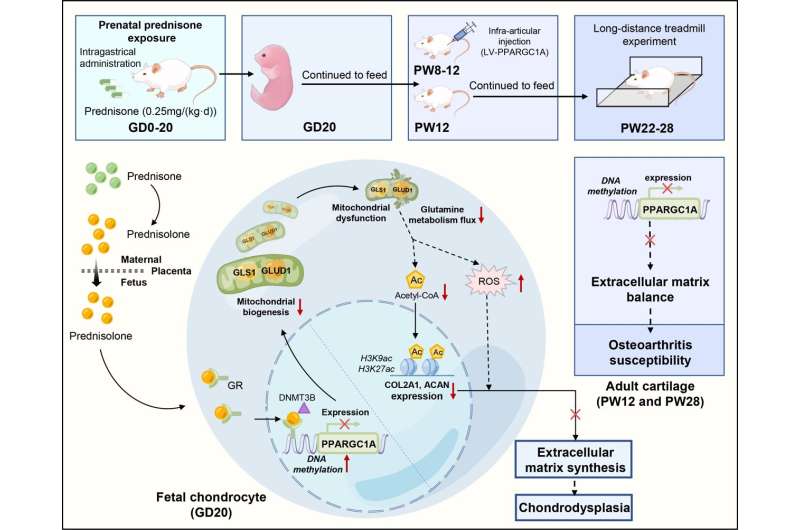
A research team, delving into the impact of excessive prenatal prednisone exposure (PPE) on fetal development, discovered that PPE leads to chondrodysplasia in female offspring and enhances their susceptibility to osteoarthritis (OA) in adulthood. The study also proposes that early targeting of PGC-1α could be a potential interventional strategy for PPE-induced OA susceptibility.
The collaborative research from Zhongnan Hospital of Wuhan University and the School of Basic Medical Sciences at Wuhan University has been published online in Science China Life Sciences. The paper is titled “Activation of the PGC-1α-mediated mitochondrial glutamine metabolism pathway attenuates female offspring osteoarthritis induced by prenatal excessive prednisone.”
The research team initially established a rat model to simulate the condition of excessive prenatal prednisone use and employed a long-distance running stimulus postnatally to mimic the progression of OA. Through this model, investigators observed that, compared to the control group, the PPE group’s female adult offspring exhibited reduced cartilage quality, which was further exacerbated after long-distance running stimulation.
The researchers also found that the effects of PPE on cartilage can be traced back to the fetal development stage, where chondrodysplasia is closely associated with the development of OA in later life.
The team further explored the molecular mechanisms by which PPE affects cartilage development. They discovered that PPE, through the active metabolite of prednisone, prednisolone, Pred (rather than prednisone), suppresses glutamine metabolic flux, leading to increased oxidative stress and decreased levels of histone acetylation and expression of chondrogenic phenotypic genes.
These alterations impact the synthesis of the cartilage extracellular matrix (ECM), thereby affecting the normal development of cartilage. Most notably, the researchers found that peroxisome proliferator-activated receptor gamma coactivator-1 alpha (PGC-1α), a key protein regulating mitochondrial biogenesis, exhibited decreased expression under the influence of PPE.
The downregulation of PGC-1α results in mitochondrial dysfunction, further affecting glutamine metabolism and the synthesis of the cartilage ECM.
To verify the potential of PGC-1α as an intervention target, the researchers employed pharmacological activators and lentiviral-mediated overexpression strategies in both in vivo and in vitro intervention experiments.
The results indicated that the activation of PGC-1α could reverse the impairments in cartilage ECM synthesis induced by PPE and Pred, restore mitochondrial function, and alleviate oxidative stress. These findings provide a significant theoretical foundation for the development of new prevention and treatment strategies, potentially helping to reduce the risk of OA due to PPE.
The study concludes by emphasizing the importance of cautious use of prednisone during pregnancy and proposes PGC-1α as a potential intervention target for the prevention and treatment of OA resulting from PPE.
This discovery is not only of great significance for understanding the pathogenesis of OA but also offers new directions for future drug development and clinical treatment.
More information:
Qingxian Li et al, Activation of the PGC-1α-mediated mitochondrial glutamine metabolism pathway attenuates female offspring osteoarthritis induced by prenatal excessive prednisone, Science China Life Sciences (2024). DOI: 10.1007/s11427-023-2593-4
Citation:
Study: Excessive prenatal prednisone exposure leads to chondrodysplasia in female offspring, osteoarthritis risk (2024, September 30)
retrieved 2 October 2024
from https://medicalxpress.com/news/2024-09-excessive-prenatal-prednisone-exposure-chondrodysplasia.html
This document is subject to copyright. Apart from any fair dealing for the purpose of private study or research, no
part may be reproduced without the written permission. The content is provided for information purposes only.


